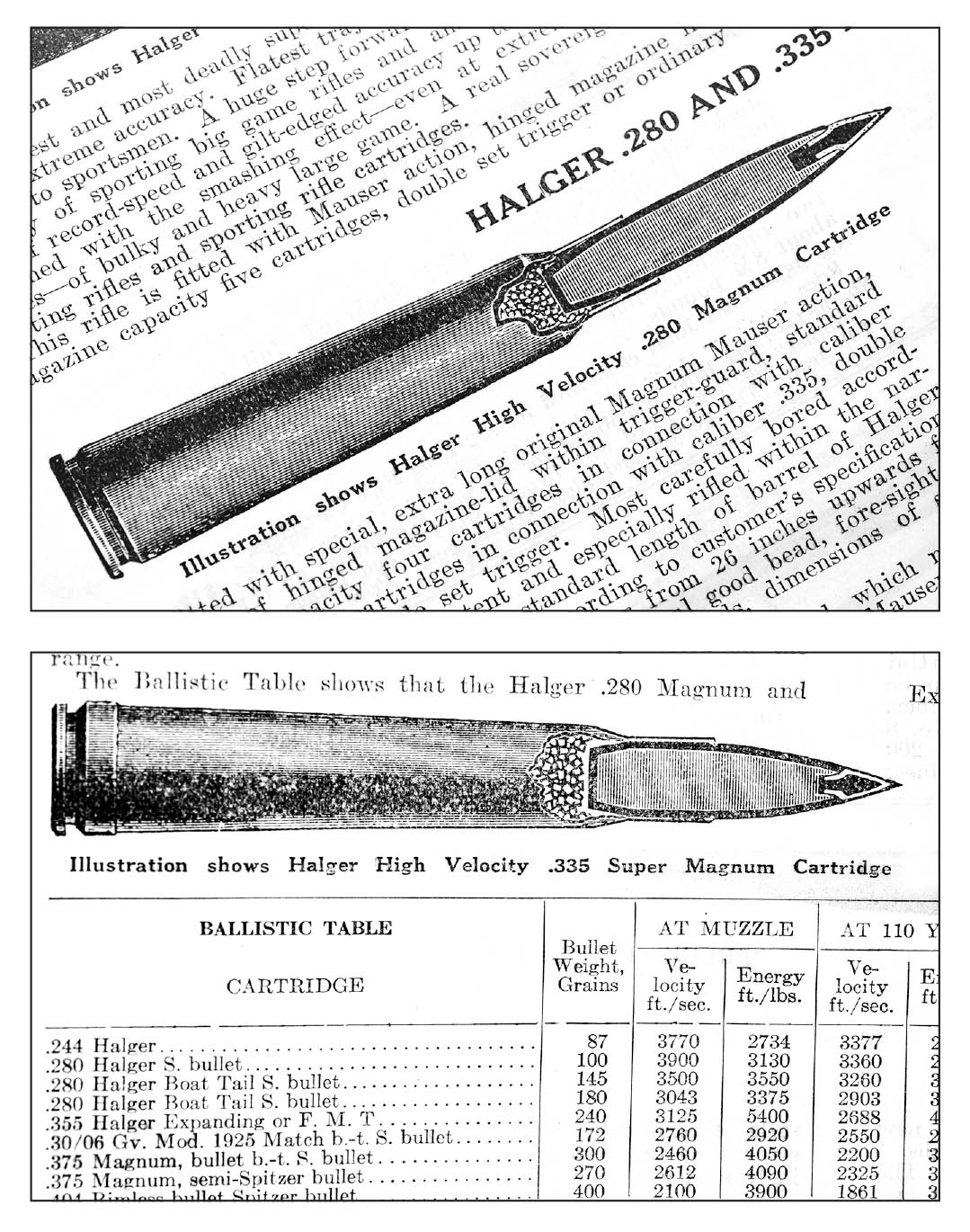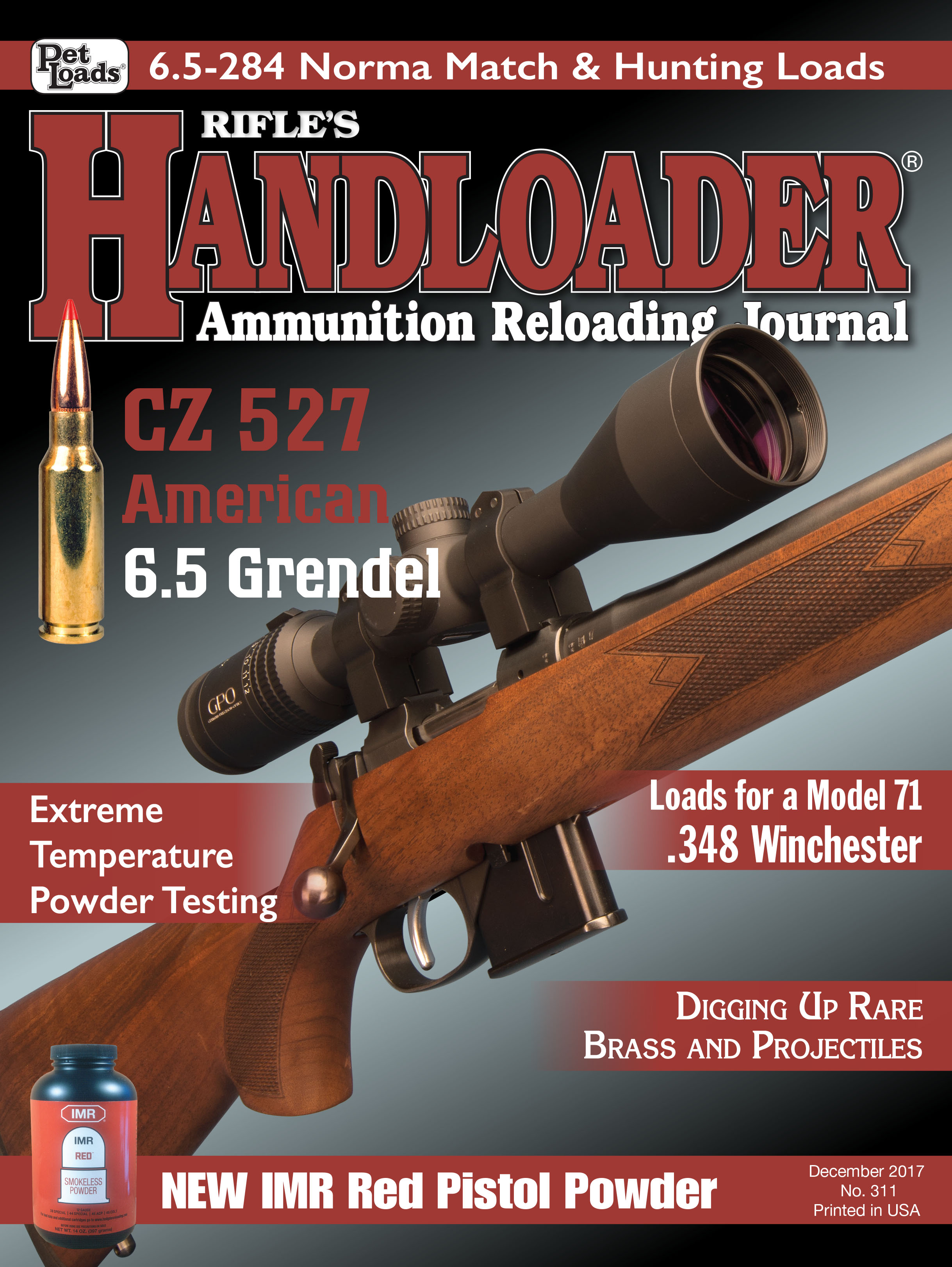In Range
The Strange Tale of Harold Gerlich
column By: Terry Wieland | December, 17
Handloading and wildcatting are natural fields for visionaries. Equally, they provide fertile soil for dreamers and hucksters. Sometimes the line separating the two is very thin indeed. Early great names include Sir Charles Ross, then Charles Newton and later Roy Weatherby.
In the 1930s, the name Harold Gerlich made headlines in the shooting press as the developer of a rifle cartridge that put

According to published figures that appeared in magazines in Germany, then in the September 1930 edition of the American Rifleman and in Stoeger catalogs in the early 1930s, the .280 Halger launched a 145-grain bullet at 3,500 fps, and a 100-grain bullet at 3,900. Not only that, but the factory Halger rifle and cartridge could produce groups in the range of 7.5 inches at 1,000 yards!
This was truly phenomenal performance, for that or any age – if it were, in fact, true. But alas . . .
Harold Gerlich was an American of German extraction who was born in St. Louis but returned to the fatherland before 1914. He worked there throughout the Great War, and after 1918 went into business in partnership with his brother-in-law, a gunsmith by the name of Halbe. Gerlich billed himself as a “ballistic engineer,” but exactly what his academic qualifications were, I don’t know. The partners set up shop in Hamburg but later moved to Kiel.
Whatever else he might have been, Harold Gerlich was a salesman. He persuaded Rottweil to make a special flake gunpowder for him. He persuaded RWS (and later DWM) to produce ammunition to his specifications. He obtained magnum Mauser actions from Oberndorf on which to build rifles, and he worked with the German ballistic testing station in Berlin-Wannsee to measure their performance.
Gerlich “designed” three cartridges: the .244 High Velocity Magnum Halger, the .280 HV Magnum Halger and the .335 Super Magnum, but the .280 was his main claim to fame. The Halger name is derived from HALbe and GERlich, not from a contraction of “Harold Gerlich,” as was sometimes reported.
The .280 Halger burst on the scene with the aforementioned article in a German ordnance magazine that was reprinted in the American Rifleman. It quoted the findings of the “Official German Testing Station for Small Arms,” located in the Berlin suburb of Wannsee, confirming the extraordinary velocities achieved with the .280 Halger.
In the 1934 Stoeger catalog, Halger rifles and ammunition are listed, complete with glowing reports of their performance. A .280 Halger rifle built on a magnum Mauser action with a 283⁄8-inch barrel was listed at $1,050 – a fabulous sum for the time – or $1,300 with a 6x Zeiss scope. In the same catalog, Stoeger lists a custom-made W&C Scott double rifle for $850, while the most expensive original Mauser sporter (with factory-mounted Zeiss scope) was $310, and a standard Winchester Model 54 was $61.40.
Just as interesting, .280 Halger ammunition cost $80 per 100 rounds, and it could not be sold except with a Halger rifle, or to “Bona Fide owners” of Halger rifles. Positively none will be sold otherwise, Stoeger insisted.
Some time around 1934, Harold Gerlich died, and his company died with him, leaving nothing but the enduring myths of his rifles and cartridges and their published ballistic performance that has hardly been matched to this day.
Toward the end of the Second World War, American writer, ballistician and army ordnance officer Philip B. Sharpe was in Europe investigating German military small-arms manufacturing. Having always been both curious and skeptical of Gerlich and his claims, Sharpe went to some lengths to gather facts.
He eventually obtained an original .280 Halger rifle and one sealed box of original 100-grain ammunition, and settled down with his chronograph to see what they could actually do. Sharpe was assisted by information he obtained from Karl Weiss, long-time director of the RWS ammunition plant in Nürnberg, who had known Gerlich personally. The results of Sharpe’s investigation and testing were reported in detail in an article in the 1953 Gun Digest.
He began by measuring the cartridges. The .244 was a modified 6.5x57 – almost identical to the .257 Roberts; the .335 had a belted case with external dimensions slightly greater than the .375 H&H. The vaunted .280 Halger was the existing .280 Ross – nothing more, nothing less. Weiss confirmed that to make Halger ammunition, RWS obtained the Ross dimensions from Kynoch in England and reproduced them.
Halger’s bullets were not original either, including a “beautiful” 180-grain spitzer boat-tail for which Halger claimed a muzzle velocity of 3,043 fps. Sharpe determined that this was a direct copy of the legendary Ross match bullet, and the Halger 143-grain bullet was a copy of the original Ross copper-tubed bullet.
Tearing three of the cartridges apart, Sharpe found they contained an average of 70.6 grains of an unidentified flake powder. It was so heavily compressed he had to return the powder to the cases in three stages, pounding each charge down with a mallet and brass rod before he could re-seat the bullets.
Sharpe’s chronograph revealed that the 100-grain Halger ammunition achieved instrumental velocity of 3,791 fps at 60 feet, which Sharpe extrapolated to 3,860 fps at the muzzle. His box of ammunition claimed 3,900 fps, but Halger ads said 3,800 fps. Those loads certainly delivered the goods, but at a cost of an extremely stiff bolt lift reminiscent of proof loads, and pressures that Sharpe estimated at 72,000 psi.
Having no factory ammunition loaded with heavier bullets, Sharpe used original Ross bullets of both 143 and 180 grains and worked up loads to his own standards of safety. Using 68 grains of IMR-4350, he came close with a muzzle velocity of 3,430 (claimed velocity: 3,500 fps). With the 180-grain bullet and 64 grains of 4350, he reached 3,025 fps (vs. 3,043 fps) with no adverse pressure signs, but ran out of bullets. The conclusion he reached was that those Halger velocities were achievable – barely – but only at extreme pressures.
I compared Sharpe’s results with my own using a .280 Ross and found that with 150-grain bullets, I ended up with flattened primers at a load of IMR-4350 that was 10 grains less than Sharpe used. Granted, my bullets were slightly heavier and I was working with Ross brass fashioned from .300 RUM cases, so capacity could have been quite different, but even so. Ten grains is a lot of powder. For the record, my velocity with that load averaged 2,975 fps.
By the time Sharpe carried out those tests, Gerlich had been dead almost 20 years, the world had gone to war and back, and the Halger company, its rifles and ammunition were no more. Sharpe’s conclusion was that Halger ballistics were no more than American wildcatters had been obtaining (albeit by skating on thin ballistic ice) for years.
The ironic thing is that, at the same time as he was debunking Gerlich’s claims, Philip B. Sharpe was pursuing an eerily similar course in promoting his own 7mm creation (7x61 Sharpe & Hart) and claiming high velocities for it (160- grain bullet, 3,100 fps) when in reality the rifles and ammunition delivered closer to 2,900 fps.
Harold Gerlich certainly crossed the line from visionary to huckster, but Phil Sharpe came perilously close to doing the same thing. It’s a funny business, ballistics


